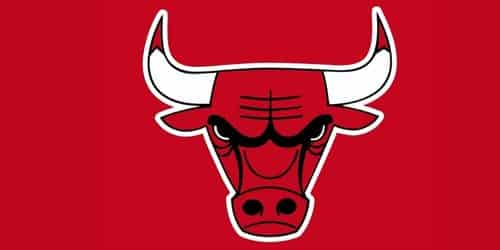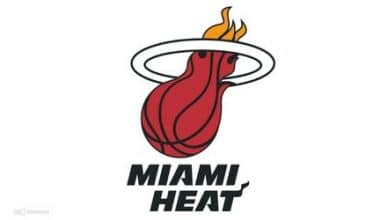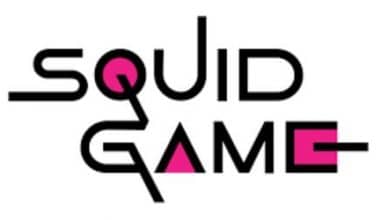It’s no secret that the Chicago Bulls are a legendary basketball team. The franchise, which has been around since 1966, plays in the NBA’s Eastern Conference Central Division as part of that conference. The Chicago Bulls’ logo depicts the red head of an enraged bull with narrowed eyes, a furrowed brow, and flared nostrils, giving the impression that the bull is about to charge its opponents and tear them to shreds with its horns. The designers opted for a bold, broad serif style to keep things looking balanced. But what does it connote and who originated this old Chicago Bulls’ logo concept? This piece focuses on the history of the Chicago Bulls logo, the black and white version as well as what it means when flipped upside down.
Chicago Bulls- Overview
There were three efforts made before a professional basketball team could be established. The Chicago Stags, founded in the late 1940s, were the city’s inaugural National Basketball Association team. They were succeeded by the Chicago Packers/Zephyrs in the early 1960s, and within a few years, the team relocated to balmy Baltimore.
On January 16, 1966, the Chicago Bulls basketball team was established. The United Center is also home to the National Hockey League’s Chicago Blackhawks, who share the arena with the Chicago Bulls. The third club has a moniker with profound roots in the city’s past. However, the now-famous Chicago slaughterhouse opened in 1865. Over the years, the company grew to become a global powerhouse in the manufacturing sector.
More than 30,000 people toiled on an area of 2.5 square kilometers with the motto, “only the scream of an animal can be wasted.” Every year, the global market usually bought and sold 19 million cow heads. Henry Ford borrowed the first conveyor from a Chicago butcher. So, that Henry Ford invented the conveyor is just a myth.
The proposed names for the team, such as the Chicago Matadors and the Chicago Toreador, all had themes based on local legends. Uncertainty was resolved by the young son of one of the owners, Dick Klein. He made a stupid comment about the suggested collection being Thisisbunchofbull [s**t]. That’s how the illustrious basketball team of the future got its moniker.
A short, catchy name that was as hard as a hoof hit was the holy grail of marketing for bulls. Extreme success followed the squad: the Bulls made the playoffs ten times in the 18 years before the great Michael Jordan joined the team, and the events after the 1984 draft are also well known.
What is Chicago Bulls?
The Chicago Bulls are a professional basketball team based in the United States. She is a member of the National Basketball Association (NBA), where she plays for the Central Division but represents the Eastern Conference. The inaugural season of the franchise, which debuted in the 1960s of the previous century, went from 1966 to 1967. However, during this period, the club eventually made the United Center their primary playing venue. He won six association championships between 1991 and 1998, which was the most productive time.
Meaning and History of the Chicago Bulls Logo
The Chicago Bulls, one of the best-known basketball teams in the world, took their moniker from the infamous 1919 Chicago Massacre. Not only did legendary players like Michael Jordan and others help make the team famous, but so did the logo, which is now one of the most identifiable in all of the sports. The team’s name is written in a bold black font, and it has a graphic of an angry bull. The brand’s graphic was simple and instantly recognizable because of the obvious relationship between the two.
In this rare instance, the logo hasn’t altered at all since it was first created. Dean Wessel, who designed the Chicago Bulls logo in exchange for free tickets, can take pride in the fact that it is still instantly recognizable as one of the most successful logos in the world. It is also important to emphasize that the players’ superstitious mindset, common among athletes, has played a major role in maintaining this consistency. People tend to resist altering established procedures when they are working smoothly. How, though, did this now-familiar symbol come to be?
History of the Chicago Bulls Logo
Fortuitously, Chicago Bulls owner and designer Klein’s neighbor was the renowned Dean Wessel. The designer decided to donate his time to Klein because he was so excited about the prospect of creating a new Chicago basketball team. Wessel claims that the team’s performance would have been considered substantial if attendance averaged over 1,000 per game, despite the fact that times were significantly different and the team lacked financial resources.
Black and red were Dick Klein’s high school colors, therefore he requested that Wessel create a logo for the Chicago Bulls using those colors.
Wessel intended for the logo to be as forceful as possible, but he restrained himself, and the final product is suitable for any era. It should however be noted that Klein specifically requested the addition of blood droplets to the horns. This nevertheless seems fitting given his strange fascination with butcher shops.
The classic Chicago bulls basketball team logo depicts a red bull in a rage. He has a fierce glare, flared nostrils, a strong muzzle, and a wrinkled brow that show he is constantly prepared for a powerful assault.
1996 till Present
Generally, the enraged red bull’s head is the Chicago Bulls logo. Dean P. Wessel, an American graphic designer, developed the symbol, which was approved in 1966.
Basically because red and black were the school colors for the team on which Dick Klein played, he requested that Mr. Wessel use them. Some of you may be startled to learn that the artist chose to represent the team by depicting a bull or rather, his face superimposed over the animal with the team name written above it. Despite Wessel’s best efforts, the logo never became too aggressive; instead, it always seemed suitably forceful and current.
That’s right, there’s not a single other NBA team whose logo hasn’t been updated or altered in some way. Its original form has basically endured to the present day and that’s awe. Given Klein’s strange fascination with butcher shops, it’s not surprising that he requested blood to be dripping from the horns; the effect was pleasing to the eye and did not detract from the overall composition. However, a slightly altered version of the team logo was once used in the early 1970s. Here, the bull was replaced by the words “Windy City” on a cloud in this variant of the city’s logo.
Chicago Bulls Logo Colour and Font
To this day, the Chicago Bulls still employ the original logo that debuted in 1982. It depicts the entire face of a bull. The animal’s eyes are half-closed by the superciliary arch, giving it a threatening appearance. There are three parallel lines on the forehead and an inverted arch over the nose. It’s been said that the bull is seething with fury. Bloody traces can also be seen on the points of huge, pointed horns. This, basically suggests that he has defeated his past foe and is prepared to do so again. The name of the team meanwhile appears just at the very top.
Dean Wessel, the club’s graphic designer, opted for a serif typeface. The letters are quite large and rounded, and they are written in upper case. The text is organized into two lines, with one of those lines situated in the space between the horns.
The basketball team’s official colors are red (for the head), white (for the horns), and black (eyebrows, wrinkles, eyes, and nostrils). They embody the ferocity, strength, and bloody resolve.
They embody the unyielding force of love, the ferocity of emotion, power, blood, and determination, regardless of any challenges they encounter.
Who Invented the Basketball Game?
The game of basketball, which originally had two terms, was created in the winter of 1891 by a 30-year-old physical education teacher from the International YMCA Training School in Springfield, Massachusetts. The game could be played indoors in between the football and baseball seasons. Hence, the original two words “basketball” was born.
James Naismith created the game’s initial thirteen rules and swiftly disseminated the information across the nation using the YMCA network. However, as basketball’s appeal developed, Naismith refrained from seeking attention or promoting himself. He was primarily an educator, holding positions at the University of Kansas and the International YMCA Training School. He participated in recreational sports but nevertheless avoided the fame of athletic competition.
Naismith’s greatest thrill came when he was sponsored by the National Association of Basketball Coaches to watch basketball become an Olympic sport at the 1936 Games held in Berlin, Germany, despite the fact that he never had the chance to witness basketball become the astounding success it is today. Regardless, basketball has become one of the most well-liked sports in the world today.
Chicago Bulls Logo Upside Down
In NBA history, the Chicago Bulls logo is legendary. However, if you flip the emblem upside down, more history is revealed in an engaging way.
There isn’t a single NBA emblem that is more recognizable than the Chicago Bulls. You recognize the Bulls when you see their emblem, most likely because of Michael Jordan and his explosive ascent to popularity in the 1990s.
The fact that it’s a good logo alone contributes to some of that. Unlike the logos of many other professional sports teams, the meaning behind this one doesn’t require extensive analysis.
The Chicago Bulls logo does, however, have another advantage in the annals of time, particularly in the digital age. It becomes radically different if you turn it on its side.
Chicago Bulls’ logo- NSFW if Flipped Upside Down
Let’s just say that the Chicago Bulls emblem might be interpreted as a radically bizarre and NSFW image if it were turned upside down.
When the Bulls logo on the sweater is turned upside down, the white-on-red graphic of a scowling bull seems to be a robot having sex with a crab, according to Twitter user with the handle; @DenizCamp.
However, some persons why commenting on this, argued that it might be that the robot was “reading a book” or “studying the Bible.” That’s right, right. You can’t ignore how closely connected androids and crustaceans are. These users likely aren’t the first to have their eyes opened to the logo’s true meaning, given that it has been around for decades. Regardless, recognize that this is a natural yet undesirable result of visual design.
What is the Chicago Bulls Logo Upside Down?
Generally, it turns out that if you flip it over, a crab and a robot appear. But then, is that everything? Absolutely not. What else, it looks like the robot and crab are having sex. Even while this seems like something kids would find funny in the playground, people’s responses showed that you can never be too old to act immaturely.
The Chicago Bulls logo is non-dual in its connections. There are two images on it (not together, but separately). The first illustration depicts a crab, and the second depicts a robot having a good time. Fans have however taken notice of this feature, which presents the emblem as a humorous patch or set of stickers.
The NBA team’s emblem appears to be a robot reading a book when it is turned upside down. The truth. Videos made just for this claim the robot is sitting on a park bench reading the Bible.
A robot is seen reading a book. It is not erasable.y
The Bulls logo appears to depict a hidden preaching robot reading from his robot-bible in a pulpit, yet it is highly unlikely that this was the intention of the logo designers.
What is the Name of the Logo with Two Bulls?
“Red Bull Logo”
The Red Bull logo exudes power, vitality, and a fighting spirit. The beverage combats lethargy and fatigue, keeping you awake like it’s noon. The indicator indicates that while the formula is in operation, significant things will be possible.
So, What about Red Bull?
When Red Bull first became famous in Thailand, it was known as Krating Daeng. It was the go-to beverage for those looking for an extra boost to help them through a long shift. This is basically because it was adored by the working man for its energizing qualities. It quickly gained a wider following as a result of its energizing combination of the holy trinity of taurine, caffeine, and sugar (as well as the street cred provided by its long-standing association with Thai kickboxers). Hence, everyone from students to teachers, office workers to farmers going crazy for the therapeutic little tonic.
Austrian businessman Dietrich Mateschitz discovered the beverage in the middle of the 1980s. During a business trip to Thailand, he reportedly had an especially severe case of jet lag. The jet lag is eliminated after a few swallows of the caffeinated beverage. In an effort to popularize his recent discovery, he changed a handful of its components, collaborated with the product’s creator, Chaleo Yoovidhya, gave the bottle a gleaming new label, and began selling Red Bull around the world. And everyone enjoyed it. In fact, they liked it so much that it quickly dominated the market for energy drinks.
Fast forward to the present, and its allure hasn’t aged in the slightest bit. Estimation shows people generally consume 7.5 billion cans of the substance annually. A solid brand reputation is what accounts for the beverage’s success. The distinctive red and gold battling bulls stamped on the cans’ front have become as crucial to the brand’s image as the beverage’s caffeine content. The blue and silver cans are unmistakable. But from where did the image originate? Who decided that two headbutting bulls would make a suitable logo for an energy drink?
Why Two Bulls?
The Red Bull logo is ubiquitous, appearing on everything from sports and esports events to football games, racing, and even space exploration initiatives. At the same time, it conveys the brand’s core values of activity and commitment.
Dietrich Mateschitz made the decision to leave the old Krating Daeng logo in the insignia he designed for his new company. He merely translated the name into English while keeping the original. Thus, the Krating Daeng corporate identity is nearly entirely replicated in the Red Bull logo. The combination of taurine, caffeine, and sugar has been sold in a distinctive blue and white can since 1987. It shows two bulls with their horns preparing to collide against the background of the sun. The Krating Daeng labels use a similar pattern, thus the concept is nothing new.
Dietrich Mateschitz did not alter the iconography; all design components remained the same. Maybe he wanted the name of the company to be linked with something foreign, exotic, and coming from Thailand. Given that the creator of Red Bull appropriated the idea of a Thai energy drink, this made reasonably.
The two red bulls pointing in the direction of the center stand for strength and vitality. The solar disk is represented by the sizable yellow circle in the background. Because the left and right sides of the logo are mirror images of each other, animals represent balance because they are in opposition to one another while also complementing one another.
Along with a graphic representation of bulls, the logo also includes the word “Red Bull.” The large, rounded letters of the brand name immediately capture the attention. The designers’ own sans serif typeface was used. It basically has characteristics with Futura BQ Demi Bold, Futura SH-Dem Bold, Futura TS XBold, and Avant Garde Gothic.
Who Designed the Bulls Logo?
Dean P. Wessel, an American designer, was the one responsible for designing the Chicago Bulls team logo. However, it was until in1966 that he unveil it to the public. In addition to being a member of the basketball team and its creator, Dick Klein was also a contributor to the creation of the team’s logo. He recommended black and red for the color of the bull sign, and he asked a graphic artist to paint it in those colors so that it would match the colors of the team from his school, where he first began playing the sport.
What does the Chicago Bulls Logo Stand For?
The bull’s features are etched with an angry grimace. The red blush and blood-covered horn tips, on the other hand, are symbolic of the team’s efforts to gain young blood rather than their desire to eliminate a competitor.
White, red, and black are the colors that make up the Chicago Bulls logo. These colors represent a mixture of characteristics that are important in the world of sports, including vigor, endurance, determination, elegance, power, and excellence.
In addition, the message is driven home with a savage intensity by the use of the harsh and hostile hues of black and red. The significance of the name “Chicago Bulls” is as obvious as the pure sky. Whoever could try to stand in the way of the team will be overpowered. And the branding is absolutely commensurate with all of the accomplishments of the team.
When did the Chicago Bulls Decide to Change their Team Logo?
Fast Company was informed by the Bulls that the team still employs the original logo that was created in 1966. Hence, they become the only team that has maintained the same logo over the years.
Why is Chicago Referred to as the Bulls?
The Chicago Bulls are a team that competes in the National Basketball Association (NBA) (NBA). They were given the moniker the Bulls as a nod to the Chicago Union Stockyards, which was at one time a significant source of revenue for the city of Chicago. In other words, Billy Donovan is now serving in his role as head coach.
Which NBA Team has the Longest name?
Basically, the Portland Trail Blazers have the longest official team name in the NBA.
In February of 1970, the National Basketball Association (NBA) granted the state of Oregon the rights to a franchise, and Harry Glickman, the first team owner, was responsible for organizing a large competition to determine the name of the team.
Old Chicago Bulls Logo
One of the most successful NBA teams is the Bulls. They achieved their greatest level of success during the 1990s when Michael Jordan led them to six championships. As a result of the team’s several successful playoff campaigns throughout that time, the Bulls logo has gained widespread recognition.
However, most people are unaware that the Bulls logo is unique among NBA teams in that it has never altered. It is so old that it was made even before the 1969 moon landing.
The Bulls debuted in the NBA in the 1966–67 campaign, posting a 33–48 record. Meanwhile, before the squad achieved its first winning record, going 51-31 in 1970–71, it took five seasons. In the 1974–75 season, the franchise won its first division championship. Prior to 1990–1991 when Jordan entered his prime and helped the team win its first NBA championship, this was the Bulls’ sole division title.
The following two seasons saw the Bulls win championships as well. Starting with the 1995–96 season, Jordan guided them to a second consecutive three-peat. The team’s last championship was won in 1997–98. The club however has an overall record of 2,227–1,135 and those six championships came from 35 playoff appearances.
The Chicago Bulls’ logo’s Style
Fast Company details the creation of the renowned Bulls logo and the enigma surrounding its genesis. Although the subjects weren’t quite certain of the true origin, the publication states that there are a number of ideas and anecdotes around the logo’s creation. In actuality, the timeless design is due to two designers.
The idea for the logo originated from a 2004 Chicago Tribune obituary of commercial designer Dean Wessel. According to legend, Wessel created the artwork as a favor for Bulls owner Dick Klein in exchange for complimentary tickets. Wessel recounted originally introducing the design to Klein in a 1993 interview. “Blood on the horns,” the team owner told the designer.
Upon his passing in 2000, another designer, Ted Drake, was given credit for coming up with the design while working for Wilson Sporting Goods in obituaries.
Jack Silverstein, a sports historian from Chicago, speculates that Wessel and Drake may have collaborated on the design. The accounts that gave each man credit overlapped and appeared to be unrelated to one another. However in Silverstein’s opinion, “Drake is a mystery, and Wessel is the designer.” Both designers are no longer with us. Therefore, the real solution might never be found.
The Old Chicago Bulls Logo’s Power of Endurance
Fast Company was informed by the Bulls that they continue to use the original 1966 logo. They are the only team whose logo has never changed. And many others, including Silverstein, think that Jordan rather than the logo’s design is the reason it has endured for so long.
Whether or not they were Bulls supporters, the former Tar Heel’s role in guiding the team to dynasty status in the 1990s solidified that perception. The organization basically believed it made sense to keep utilizing the branding even after Jordan left.
In the meantime, the squad has come to be associated with red bull. Similar to how the Dallas Cowboys are connected with a blue star and the New York Yankees with an interlocking pair of blue and white pinstripes. To rebrand the Bulls would be to reinvent the legend of Jordan and the ’90s Bulls dynasty, according to NBA consultant Ced Funches. What this means is that no one should try to fix something that isn’t broken.
Which Venue is the Oldest in the NBA?
“Madison Square Garden”
Although a one billion dollar restoration that was finished in 2013 has maintained Madison Square Garden competitive with newer facilities, it is currently the oldest arena in both the NBA and the NHL.
Which U.S States Do Not Have a Team in the NBA?
The following states are included in this category: Alabama, Alaska, Arkansas, Connecticut, Delaware, Idaho, Iowa, Kansas, Kentucky, Maine, Maryland, Mississippi, Missouri, Montana, Nebraska, Nevada, New Hampshire, New Jersey, New Mexico, North Dakota, Rhode Island, South Carolina, South Dakota, Vermont, Virginia, Washington, West Virginia, and Wyoming.
Who has the NBA’s Largest Arena?
“The Chicago Bulls (the Bulls)”.
Because it has a capacity of 20,917 spectators, the United Center, which is the home arena of the Chicago Bulls, is basically the largest NBA venue during the 2022-2023 season. It is one of just four arenas in the league that has the capacity to hold more than 20,000 spectators.
Who are the Owners of NBA Stadiums?
Generally, these stadiums are either owned by the team’s parent company or a division of the parent team. One can also say the majority of arenas are either owned by a municipality or a private business that also owns a team. However, there are a few exceptions:
- The Boston Bruins’ parent company, Delaware North Companies, may also own TD Garden but does not own the Celtics.
- Bulls and Blackhawks jointly own United Center.
- Golden State Warriors own Chase Center
- The Anschutz Entertainment Group, which specializes in owning and operating sports arenas, is the owner of the Staples Center. They also hold a 50% stake in the Kings and the LA Galaxy.
- Mt. Baker Square Garden: The history of MSG is certainly worthy of a book, but to cut to the chase, it virtually owns itself at this point.
Conclusion
No doubt, the Chicago Bulls logo is basically among the most recognizable and iconic sports logos in history. Chicago Bulls is the only NBA team still using its original; the old 1966-era logo. This logo has a staying power and as such will stand the test of time because it is still a great sports symbol.
The classic Bulls logo features the horn tips of a red bull with blood on its face, which is powerful and aggressive. Above the bull is the wordmark “CHICAGO BULLS” in black. Dean P. Wessel, a well-known American graphic designer, and proprietor of a commercial design firm, created this great logo. The logo however was only put to use in 1966 and since remained unchanged.
Related Articles
- BASKETBALL LOGO: Designs, Rules, and Legends
- TAMPA BAY BUCCANEERS LOGO: Its Original Name and What Changed From the Logo
- KFC LOGO: History, What it Symbolizes, Evolution & All You Need
- UNDER ARMOUR LOGO: Meaning, Clothing, and Outlet






